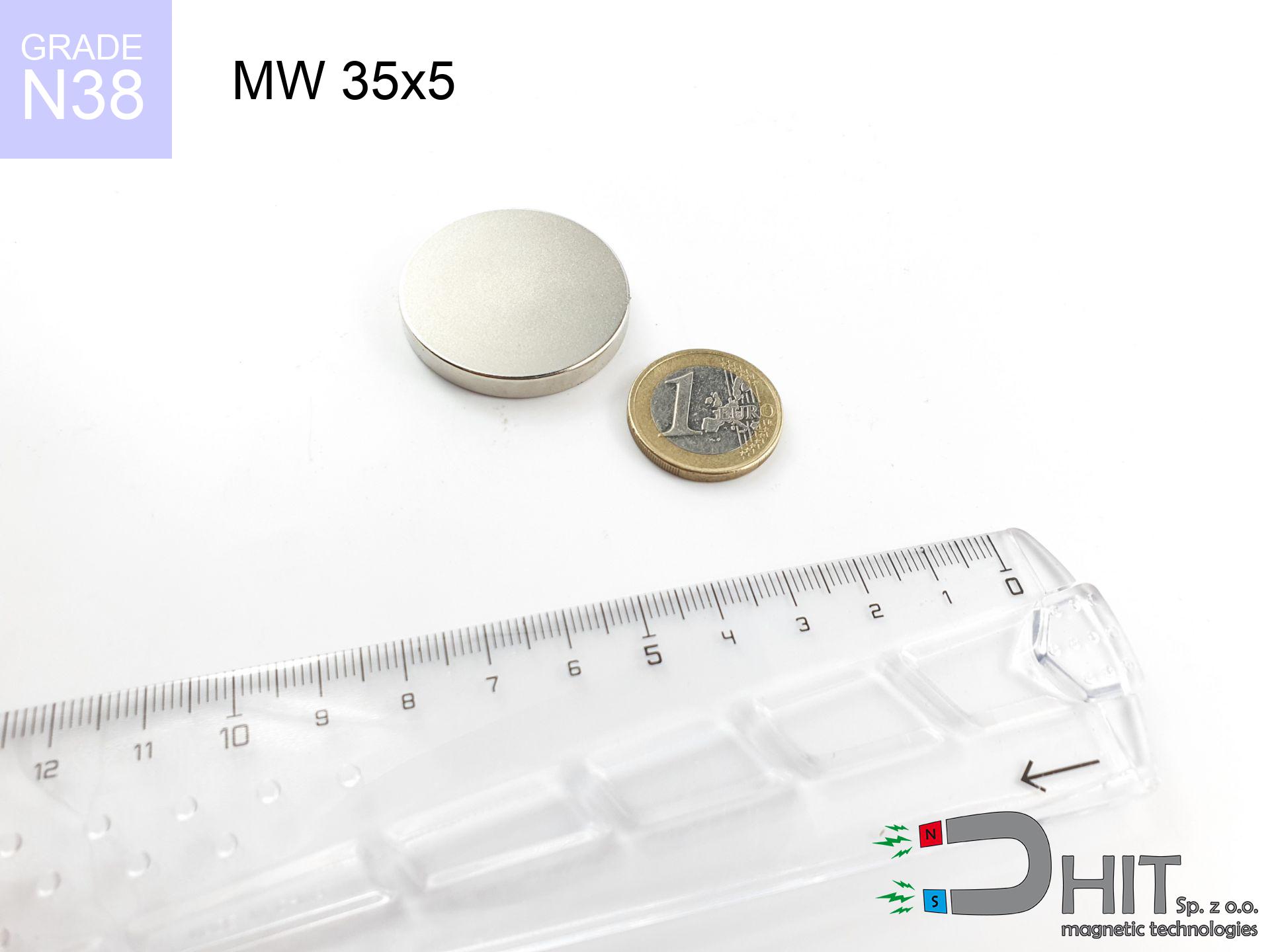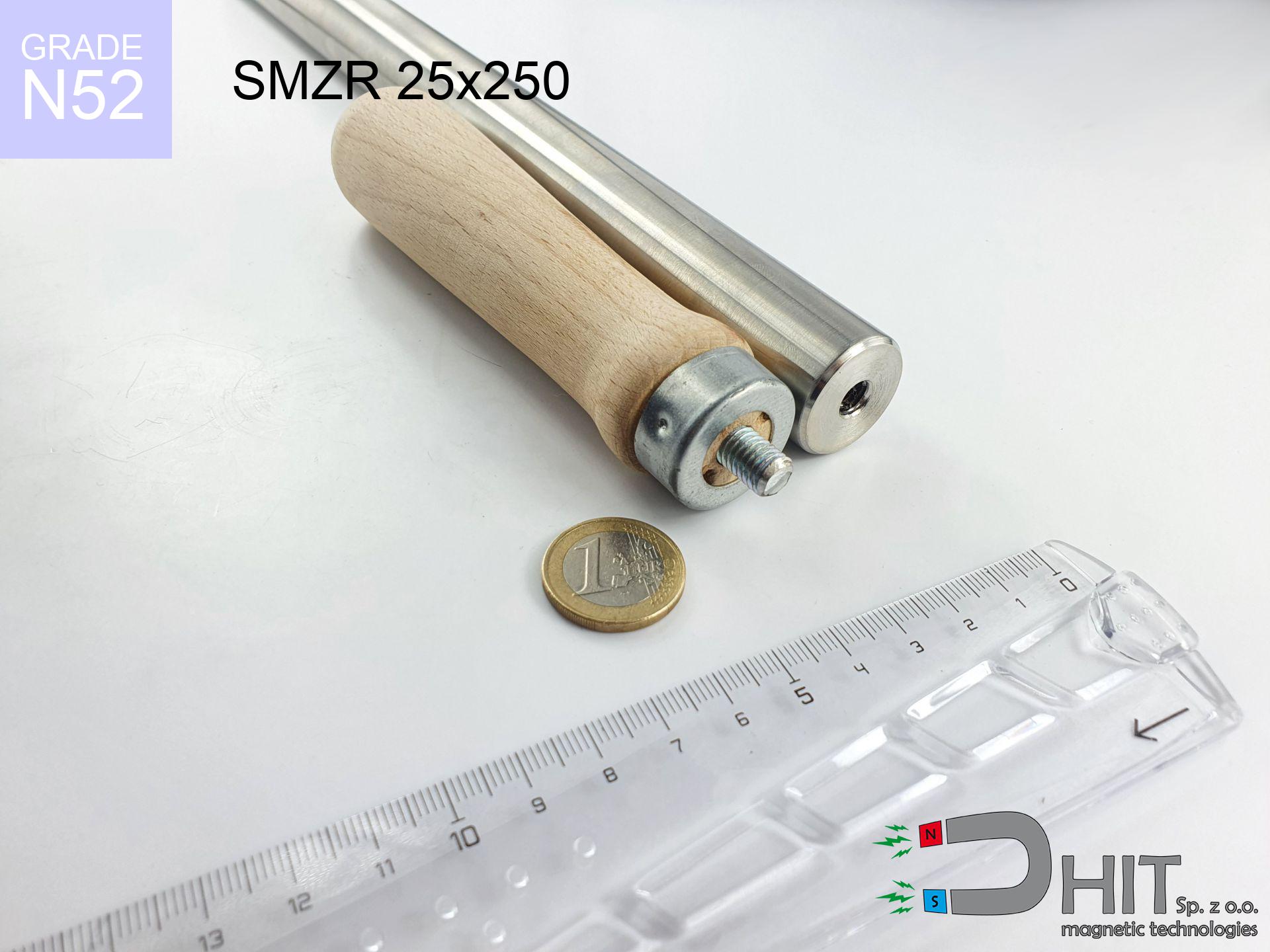UMH 42x9x46 [M6] / N38 - magnetic holder with hook
magnetic holder with hook
Catalog no 310429
GTIN/EAN: 5906301814580
Diameter Ø
42 mm [±1 mm]
Height
46 mm [±1 mm]
Height
9 mm [±1 mm]
Weight
90 g
Magnetization Direction
↑ axial
Load capacity
66.00 kg / 647.24 N
Coating
[NiCuNi] Nickel
35.99 ZŁ with VAT / pcs + price for transport
29.26 ZŁ net + 23% VAT / pcs
bulk discounts:
Need more?
Contact us by phone
+48 22 499 98 98
alternatively let us know by means of
our online form
the contact page.
Force along with appearance of magnets can be estimated using our
our magnetic calculator.
Orders submitted before 14:00 will be dispatched today!
Physical properties - UMH 42x9x46 [M6] / N38 - magnetic holder with hook
Specification / characteristics - UMH 42x9x46 [M6] / N38 - magnetic holder with hook
| properties | values |
|---|---|
| Cat. no. | 310429 |
| GTIN/EAN | 5906301814580 |
| Production/Distribution | Dhit sp. z o.o. |
| Country of origin | Poland / China / Germany |
| Customs code | 85059029 |
| Diameter Ø | 42 mm [±1 mm] |
| Height | 46 mm [±1 mm] |
| Height | 9 mm [±1 mm] |
| Weight | 90 g |
| Magnetization Direction | ↑ axial |
| Load capacity ~ ? | 66.00 kg / 647.24 N |
| Coating | [NiCuNi] Nickel |
| Manufacturing Tolerance | ±1 mm |
Magnetic properties of material N38
| properties | values | units |
|---|---|---|
| remenance Br [min. - max.] ? | 12.2-12.6 | kGs |
| remenance Br [min. - max.] ? | 1220-1260 | mT |
| coercivity bHc ? | 10.8-11.5 | kOe |
| coercivity bHc ? | 860-915 | kA/m |
| actual internal force iHc | ≥ 12 | kOe |
| actual internal force iHc | ≥ 955 | kA/m |
| energy density [min. - max.] ? | 36-38 | BH max MGOe |
| energy density [min. - max.] ? | 287-303 | BH max KJ/m |
| max. temperature ? | ≤ 80 | °C |
Physical properties of sintered neodymium magnets Nd2Fe14B at 20°C
| properties | values | units |
|---|---|---|
| Vickers hardness | ≥550 | Hv |
| Density | ≥7.4 | g/cm3 |
| Curie Temperature TC | 312 - 380 | °C |
| Curie Temperature TF | 593 - 716 | °F |
| Specific resistance | 150 | μΩ⋅cm |
| Bending strength | 250 | MPa |
| Compressive strength | 1000~1100 | MPa |
| Thermal expansion parallel (∥) to orientation (M) | (3-4) x 10-6 | °C-1 |
| Thermal expansion perpendicular (⊥) to orientation (M) | -(1-3) x 10-6 | °C-1 |
| Young's modulus | 1.7 x 104 | kg/mm² |
Elemental analysis
| iron (Fe) | 64% – 68% |
| neodymium (Nd) | 29% – 32% |
| boron (B) | 1.1% – 1.2% |
| dysprosium (Dy) | 0.5% – 2.0% |
| coating (Ni-Cu-Ni) | < 0.05% |
Sustainability
| recyclability (EoL) | 100% |
| recycled raw materials | ~10% (pre-cons) |
| carbon footprint | low / zredukowany |
| waste code (EWC) | 16 02 16 |
Other products
Strengths as well as weaknesses of Nd2Fe14B magnets.
Benefits
- They do not lose strength, even after approximately 10 years – the drop in power is only ~1% (according to tests),
- Magnets very well defend themselves against demagnetization caused by ambient magnetic noise,
- A magnet with a shiny gold surface has an effective appearance,
- Magnets possess exceptionally strong magnetic induction on the outer layer,
- Due to their durability and thermal resistance, neodymium magnets are capable of operate (depending on the shape) even at high temperatures reaching 230°C or more...
- Possibility of exact shaping and adjusting to defined requirements,
- Versatile presence in electronics industry – they are commonly used in data components, electromotive mechanisms, advanced medical instruments, as well as complex engineering applications.
- Relatively small size with high pulling force – neodymium magnets offer strong magnetic field in tiny dimensions, which enables their usage in miniature devices
Disadvantages
- They are prone to damage upon too strong impacts. To avoid cracks, it is worth securing magnets in special housings. Such protection not only shields the magnet but also improves its resistance to damage
- Neodymium magnets lose their force under the influence of heating. As soon as 80°C is exceeded, many of them start losing their force. Therefore, we recommend our special magnets marked [AH], which maintain durability even at temperatures up to 230°C
- Due to the susceptibility of magnets to corrosion in a humid environment, we suggest using waterproof magnets made of rubber, plastic or other material resistant to moisture, in case of application outdoors
- We recommend a housing - magnetic mechanism, due to difficulties in producing threads inside the magnet and complex forms.
- Possible danger to health – tiny shards of magnets pose a threat, if swallowed, which is particularly important in the aspect of protecting the youngest. It is also worth noting that small components of these products are able to complicate diagnosis medical after entering the body.
- With budget limitations the cost of neodymium magnets can be a barrier,
Lifting parameters
Detachment force of the magnet in optimal conditions – what it depends on?
- with the contact of a yoke made of special test steel, ensuring full magnetic saturation
- with a cross-section no less than 10 mm
- with a plane free of scratches
- with zero gap (no coatings)
- under vertical force direction (90-degree angle)
- in temp. approx. 20°C
Practical aspects of lifting capacity – factors
- Clearance – existence of any layer (rust, tape, air) acts as an insulator, which lowers capacity steeply (even by 50% at 0.5 mm).
- Direction of force – maximum parameter is obtained only during pulling at a 90° angle. The force required to slide of the magnet along the plate is typically several times smaller (approx. 1/5 of the lifting capacity).
- Base massiveness – insufficiently thick sheet does not accept the full field, causing part of the flux to be lost into the air.
- Steel type – low-carbon steel attracts best. Alloy steels decrease magnetic permeability and holding force.
- Surface quality – the more even the plate, the better the adhesion and higher the lifting capacity. Unevenness creates an air distance.
- Temperature influence – hot environment weakens magnetic field. Too high temperature can permanently demagnetize the magnet.
Holding force was tested on a smooth steel plate of 20 mm thickness, when a perpendicular force was applied, however under attempts to slide the magnet the load capacity is reduced by as much as fivefold. In addition, even a slight gap between the magnet’s surface and the plate reduces the lifting capacity.
Precautions when working with neodymium magnets
Threat to electronics
Avoid bringing magnets close to a purse, laptop, or screen. The magnetic field can permanently damage these devices and erase data from cards.
Fire risk
Dust generated during grinding of magnets is combustible. Avoid drilling into magnets without proper cooling and knowledge.
Conscious usage
Use magnets consciously. Their immense force can shock even experienced users. Stay alert and respect their force.
Phone sensors
Be aware: neodymium magnets produce a field that interferes with sensitive sensors. Keep a safe distance from your phone, device, and navigation systems.
Danger to the youngest
Strictly store magnets away from children. Risk of swallowing is significant, and the effects of magnets connecting inside the body are fatal.
Power loss in heat
Avoid heat. Neodymium magnets are sensitive to temperature. If you require resistance above 80°C, inquire about HT versions (H, SH, UH).
Fragile material
Despite the nickel coating, neodymium is brittle and not impact-resistant. Do not hit, as the magnet may crumble into sharp, dangerous pieces.
Warning for heart patients
People with a pacemaker should maintain an large gap from magnets. The magnetism can disrupt the operation of the life-saving device.
Crushing risk
Large magnets can break fingers instantly. Under no circumstances put your hand between two strong magnets.
Allergy Warning
Some people have a hypersensitivity to nickel, which is the typical protective layer for NdFeB magnets. Frequent touching may cause a rash. We suggest wear protective gloves.

![Holder with hook UMH 42x9x46 [M6] / N38 Holder with hook UMH 42x9x46 [M6] / N38](https://cdn3.dhit.pl/graphics/banners/magnet.webp)
![UMH 42x9x46 [M6] / N38 - magnetic holder with hook](https://cdn3.dhit.pl/graphics/products/umh-42x9x46-m6-vat.jpg)
![UMH 42x9x46 [M6] / N38 - magnetic holder with hook - ujęcie 2](https://cdn3.dhit.pl/graphics/products/umh-42x9x46-m6-dum.jpg)
![UMH 42x9x46 [M6] / N38 - magnetic holder with hook - ujęcie 3](https://cdn3.dhit.pl/graphics/products/umh-42x9x46-m6-sij.jpg)



![UI 45x13x6 [C321] / N38 - badge holder UI 45x13x6 [C321] / N38 - badge holder](https://cdn3.dhit.pl/graphics/products/ui45x13x6-c321-jic.jpg)

